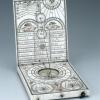Embriachi Casket (3D)
Commentary
Octagonal marriage casket made in the Embriachi workshop, northern Italy, early 15th century. Height: 38.4 cm; Width: 33.5 cm.
Each side has two ivory plaques within an architectural setting; on the base are scenes of the Judgement of Paris; on the lid are the seven virtues and two guard figures standing above the keyhole, which is no longer functional. The casket was clearly made by the Embriachi workshop, the ivory plaques of which often show scenes from classical mythology, and whose wooden structures contain geometric patterns achieved through a technique called certosina. This technique, in which stained woods, bone (usually horse or ox) and horn are inlayed, was a specialist skill of many craftsmen active in Venice during this time.
Although the exact location of the Embriachi workshop is unknown, the use of certosina indicates it was active in Venice, which is supported by documentation of members of the Embriachi family in the S Luca area around 1431. The family was also tied to Florence, particularly the church of S Maria Novella. The workshop had many prestigious patrons from northern Italy and Burgundy and mass-produced caskets, similar to this one, which survive in collections all over the world (see 'external links').
Select Bibliography
A. Boström, 'Embriachi,' Grove Art Online, https://doi.org/10.1093/gao/9781884446054.article.T025969 (published online 2003)
M. Tomasi, Monumenti d'avorio. I dossali degli Embriachi e i loro committenti (Pisa, 2010)

